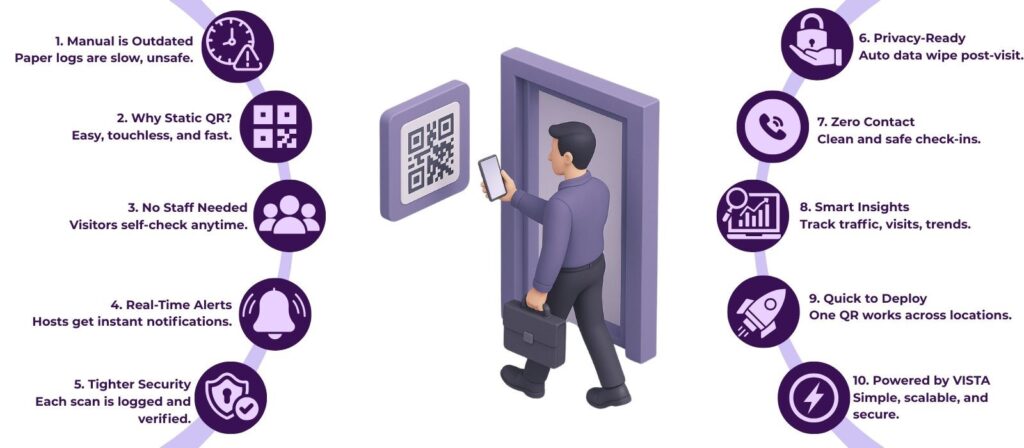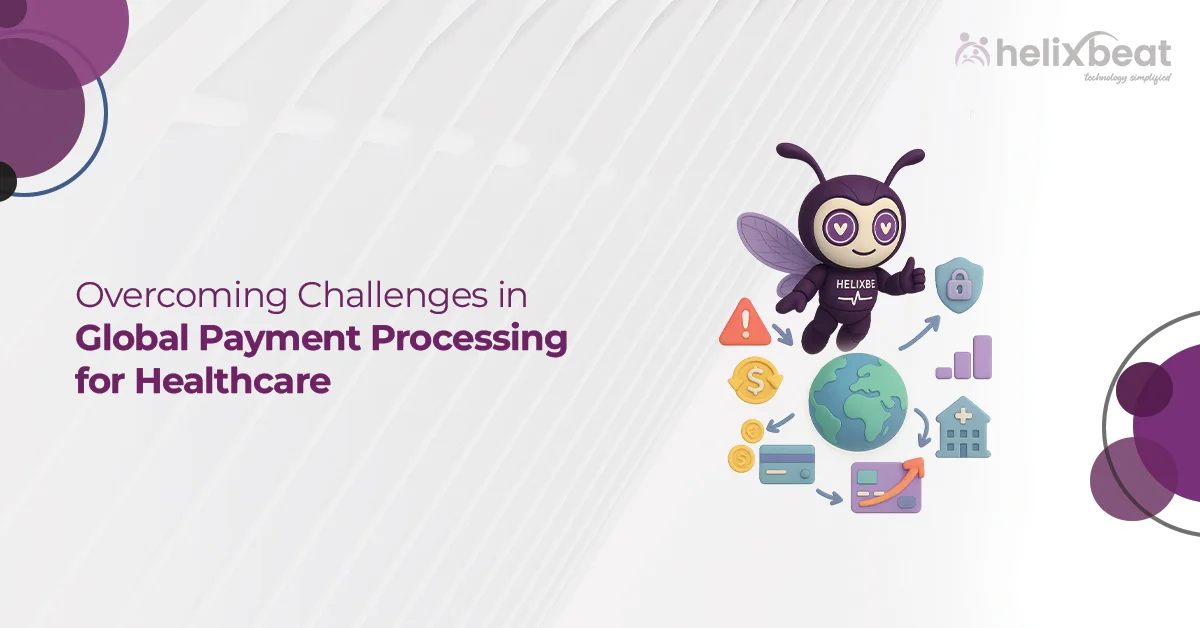Many organisations today are feeling the pressure of doing more with less. Budget cuts mean smaller teams and fewer resources, while security concerns — both digital and physical — continue to grow. At the same time, workplaces are evolving. Offices are no longer limited to a single front desk. With multiple sites, hybrid work models, and flexible schedules, managing who comes and goes has become more complicated than ever.
For most businesses, the front desk is still the first line of defence — and the first impression. However, relying on outdated tools like paper logbooks or manual sign-ins is no longer sufficient. They’re slow, insecure, and hard to track. That’s where smart tools like static QR codes come in. When paired with a modern visitor check-in system like VISTA, they offer a simple, secure, and touchless way to welcome visitors — no stress, no delays, just a better experience for everyone.
In this post, we address the challenges of securing the front desk and explore how static QR codes can enhance the visitor check-in process.

Table of Contents
Current Challenges in Visitor Check in System
The front desk is the first point of contact for visitors, partners, and contractors. As such, it plays a vital role in shaping both the physical security of a building and the first impression of an organization. But many businesses still rely on outdated systems that lead to inefficiencies and vulnerabilities.
1. Lack of Onsite Staff
Cost-saving strategies and distributed workplaces mean that many locations operate without a dedicated receptionist. Without someone physically present to manage visitors, there’s a higher risk of unauthorized access or data mishandling. Static QR codes eliminate this issue by enabling self-service check-in at any entry point, regardless of staffing.
2. Rising Security Risks
Modern workplaces are high-value environments, and protecting sensitive assets requires strict control over who enters the premises. Traditional sign-in sheets offer little in the way of real-time oversight or identity verification. A school visitor check in system enhanced with QR code functionality provides a much stronger line of defense.
3. Compliance Complexities
Organizations across industries are subject to increasing privacy, safety, and data retention regulations. Manual logs are difficult to audit, easy to lose, and prone to human error. By implementing a Digital Visitor Management System Software with integrated QR code check-ins, visitor data is automatically recorded, time-stamped, and securely stored — improving both transparency and compliance.
4. Inconsistent Visitor Tracking
Managing multiple sites or high volumes of guests creates a fragmented view of visitor activity. Without a centralized solution, it’s difficult to track patterns, enforce protocols, or respond to emergencies efficiently. A digital visitor management system for office using static QR codes ensures that every school visitor check in system is logged and accessible in real time across locations.
5. Manual, Time-Consuming Processes
Manual entry slows everything down. It results in long queues, frustrated guests, and overburdened administrative teams. QR-based check-in simplifies this entire process — giving visitors the ability to register themselves in seconds using just their smartphone.
How Static QR Codes Improve the Visitor Check-In Experience
Integrating static QR codes into a visitor check in system turns a once-clunky process into a seamless, automated experience. Placed at reception desks, entryways, or kiosks, these codes enable touchless check-ins without sacrificing security or control.
1. Frictionless Self-Service Check-In
Once generated, static QR codes can be scanned by any visitor using their mobile device. The scan directs them to a digital sign-in page, where they can fill out forms, accept terms, and confirm their identity — all in one smooth motion. No staff assistance is required, and no hardware setup is needed beyond the QR code itself.
This improves efficiency and eliminates bottlenecks, particularly in high-traffic areas or during peak hours.
2. Instant Notifications and Access Authorization
A QR-driven visitor check in system can automatically notify hosts when their guests arrive. It can also trigger access permissions if configured — such as unlocking doors or printing temporary badges.
This creates a seamless flow, as visitors can enter authorized areas immediately upon approval, without delays or manual intervention.
3. Improved Security and Accuracy
Every QR scan is linked to a unique visitor session. This makes it easier to confirm identities, verify authorization, and track movements throughout the premises. Unauthorized access attempts can be flagged, and all activities are logged in real time.
With this digital audit trail, security teams gain immediate visibility, and compliance officers can access accurate records during inspections or investigations.
4. Supports Privacy and Compliance
Modern Digital Visitor Management System Software supports role-based access, data expiration policies, and automatic data anonymization. QR-based check-ins enhance this further by allowing data to be captured securely and deleted once the visit ends — aligning with privacy regulations like GDPR and HIPAA.
Static QR codes reduce the chances of misfiled or lost personal data, offering both visitors and organizations peace of mind.
5. No Touch, No Contact, No Waiting
Health and safety are still top-of-mind in many workspaces. A touchless check-in process, powered by static QR codes, reduces physical contact and minimizes exposure to shared surfaces.
The process is faster, cleaner, and far more professional — all critical components of a modern visitor management system for office.
Visitor Insights and Analytics in Real Time
Beyond operational efficiency, static QR codes provide deep insights into visitor activity. When paired with a centralized school visitor check in system, each QR scan becomes a data point. You can track:
- Visit frequency
- Average dwell time
- High-traffic time windows
- Common access requests
- Trends in denied entries
These insights empower leaders to make informed decisions about space allocation, staffing, and security protocols.
By understanding visitor flow, organizations can optimize how their environments are used — whether that’s reallocating resources, redesigning check-in areas, or adjusting protocols for busy times.
How to Integrate Static QR Codes Into a Digital Visitor Management System
Getting started with static QR codes is straightforward, especially with modern Digital Visitor Management System Software. Here’s how organizations are successfully deploying them:
1. Create and Deploy Static QR Codes
Most systems allow administrators to generate QR codes tied to specific workflows — like guest sign-in, vendor access, or contractor arrival. These can then be printed and displayed at strategic locations such as main entrances, lobbies, or meeting room doors.
Once scanned, the code initiates a fully digital registration journey, with no need for additional hardware or scanning tools.
2. Customize Visitor Flows Based on Access Needs
Different types of visitors may require different check-in processes. With a QR-powered visitor check in system, organizations can define workflows for each category — including custom fields, NDA forms, access levels, and approval chains.
This not only improves the visitor experience but ensures consistent, policy-compliant procedures are always followed.
3. Automate Notifications, Check-Outs, and Data Management
Smart QR integrations can notify hosts automatically, trigger badge printing, and log time-in/time-out data. Once the visit is complete, access permissions are revoked, and visitor records can be deleted based on retention settings — ensuring compliance without additional work.
A well-integrated visitor management system for office handles all of this in the background, creating a fully automated process from start to finish.
How VISTA’s Static QR Code Check-In Works
VISTA uses static QR codes as a simple yet powerful tool to transform your visitor check-in experience. Unlike dynamic QR codes that change with each visit, a static QR code is fixed — it can be printed or displayed at entrances, reception desks, gates, or even sent digitally to guests ahead of time.
Here’s how the process works:
- Visitors scan the QR code using their smartphone — no app needed.
- They are redirected to a branded, secure VISTA check-in page.
- Visitors fill in their details or verify their pre-registration.
- The host is notified instantly upon check-in.
- The visitor receives approval, access instructions, or an entry pass (digital or printed).
- Upon leaving, visitors can check out with one tap, and their data is automatically cleared per privacy settings.
This simple workflow eliminates queues, removes the need for reception staff at every location, and delivers a smooth, secure first impression.
Benefits of Using Static QR Codes in VISTA
1. Touchless & Hassle-Free Entry: Visitors don’t need to download an app, wait in line, or fill out paper forms. With a quick scan, they check in instantly — saving time and improving the experience from the very first moment.
2. Works Without a Staffed Desk: At satellite offices or during off-hours, a static QR code can act as a virtual receptionist. It allows visitors to check in and complete necessary security steps, even when no one is physically present.
3. Real-Time Notifications: Once a visitor checks in, the appropriate host is notified immediately. This helps reduce delays, ensures proper access control, and maintains an efficient flow of people.
4. Stronger Security & Access Control: QR check-ins through VISTA integrate seamlessly with access permissions. Only approved visitors can proceed past the entrance, and data is logged securely in real-time for auditing and compliance purposes.
5. Smart Visitor Insights: Every check-in is tracked. Admins can view live data on who’s on-site, peak traffic hours, repeat visitors, and more. These insights help improve planning, space usage, and security decisions.
6. Easy to Deploy & Scalable: Static QR codes are easy to set up and require minimal maintenance. Whether you manage one office or twenty, you can place the same code in multiple locations and monitor activity from VISTA’s centralized dashboard.
7. Compliance & Privacy Built-In: Visitor data is automatically cleared after checkout, helping your business stay compliant with data privacy regulations. You control who can access visitor information based on roles and permissions.
Conclusion: A Smarter Way to Manage Visitors
Static QR codes are more than a convenience—they’re a critical part of a modern visitor check in system. By streamlining the check-in process, improving data accuracy, and supporting real-time oversight, they help organizations create safer, smarter, and more welcoming spaces.
To summarize, using static QR codes offers the following benefits:
- Fast, touchless visitor check-in
- Reduced reception workload
- Enhanced security and access control
- Real-time visitor data and analytics
- Improved compliance with privacy regulations
When integrated into a Digital Visitor Management System Software like VISTA, static QR codes serve as an affordable and scalable solution to today’s visitor management challenges. Whether managing one location or many, it’s a simple upgrade with powerful returns.
FAQs
Ready to modernize your visitor experience?
Learn how VISTA’s smart visitor check in system can help you deploy static QR codes, automate your workflows, and gain real-time visibility into your workplace.
What is a static QR code in a visitor check in system?
A static QR code is a fixed code that, when scanned, directs visitors to a digital check-in page—no app or hardware required.
How does a school visitor check in system benefit from QR codes?
It enables self-service check-ins, improves security, and ensures compliance without needing staff at every entry point.
Can static QR codes work without an internet connection?
No, visitors need internet access to load the digital check-in form after scanning the QR code.
Is a static QR-based visitor check in system secure?
Yes, it logs data in real time, restricts access to approved visitors, and helps maintain compliance with data privacy laws.
How is this different from dynamic QR codes?
Static QR codes don’t change and are ideal for consistent workflows, while dynamic QR codes can be updated or customized for each visitor.
Can I use static QR codes in multiple office or school locations?
Yes, the same static QR code can be deployed across multiple sites and tracked through a centralized visitor management system.














